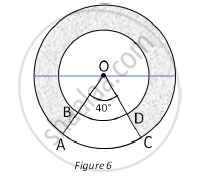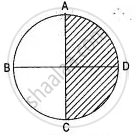Advertisements
Advertisements
प्रश्न
A wheel has a diameter of 84 cm. Find how many completer revolutions must it make to cover 3.168 km.
उत्तर
The diameter of the wheel = 84 cm
Thus, the radius of the wheel = 42 cm
Circumference of the wheel = 2 x `22/7` x 42 = 264 cm
In 264 cm, the wheel is covering one revolution.
Thus, in 3.168 km = 3.168 x 100000 cm, number of revolutions
covered by the wheel = `3.168/264 xx 100000` = 1200.
APPEARS IN
संबंधित प्रश्न
In Fig. 6, find the area of the shaded region, enclosed between two concentric circles of radii 7 cm and 14 cm where ∠AOC = 40°. (use `pi = 22/7`)

A playground has the shape of rectangle, with two semicircles on its smaller sides as diameters, added to its outside. If the sides of rectangle are 36m and 24.5m. find the area of playground.
The areas of two circles are in the ratio 9 : 4. The ratio of their circumferences is
The diameter of a wheel is 84 cm. How many revolutions will it make to cover 792 m?
The sum of the radii of two circles is 10.5 cm and the difference of their circumferences is 13. 2 cm. Find the radii of the two circles.
A cylindrical beaker of 7 cm diameter is partly filled with water. Determine the number of spherical marbles of diameter 1.4 cm that are to be submerged in it to raise the water level by 5.6 cm
AC and BD are two perpendicular diameter of a circle ABCD. Given that the area of shaded portion is 308 cm2 calculate:
(i) The length of AC and
(ii) The circumference of circle

The area between the circumference of two concentric circles is 2464cm2. If the inner circle has a circumference of 132cm, calculate the radius of the outer circle.
The area of a circle whose circumference is 22 cm, is ____________.
The numerical value of the area of a circle is greater than the numerical value of its circumference. Is this statement true? Why?
